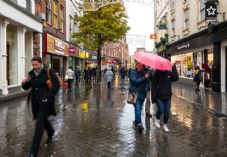UK DIY News
Footfall slows in July as poor weather impacts high street

The number of consumers shopping at the UK's high streets and shopping centres fell in July 2017, according to the latest figures from the British Retail Consortium (BRC).
The latest BRC-Springboard Footfall and Vacancies Monitor shows that shopper numbers fell by 1.1% in July, hot on the heels of BRC-KPMG figures for July that showed slowing online and offline retail sales growth.
Read - BRC Retail Sales Monitor shows slowing sales growth
Visitors to high streets were down 2.1%, whilst shopping centre numbers fell -1.3% due partly to the poorer weather in July. During the same period, shopper numbers at the UK's retail parks increased 1.7%.
It was the fourth consecutive month of footfall decline in shopping centres.
Helen Dickinson OBE, Chief Executive, British Retail Consortium:
“Most shopping destinations saw a decline in footfall in July compared with the previous year. Even high streets, which have seen fairly stable growth over recent months, reported a decline. Retail parks were the exception and have fared relatively well since March this year reflecting in part lower rental costs compared to prime and town centre locations as well as convenience for shoppers.
The overall decline in footfall translated into weak sales performance for stores in non-food particularly, which fell further into negative territory as consumers rein back spending on non-essential items.
The vacancy rate, now at its highest for a year, fails to brighten the picture for what was evidently a challenging month for retailers. Nearly one in 10 retail shops currently lie vacant and those in some vulnerable communities remain persistently empty, limiting the chances of these places to thrive. What’s more, September’s RPI which is expected to be in the region of four per cent, represents a substantial increase in business rates for retailers in April 2018. So Government’s commitment to switch to CPI indexation should really be brought forward from 2020.”
Diane Wehrle, Marketing and Insights Director, Springboard:
“July’s results might well mark a sea change in consumers’ willingness to spend, as it was the first time since January that footfall dropped during both retail trading hours and into the evening. Over the last few months the growing importance of the leisure based trip has become a key part of the narrative when talking about retail destinations, but a -0.5 per cent drop in footfall post 5pm in July is the first evidence of a tightening of purse strings on casual dining and leisure trips.
Declining footfall demonstrates that the fall in non-food sales is due to a reduced number of shoppers, so retailers maintain their in-store footfall are at a clear advantage. Despite a drop in fashion sales, consumers increased their spending on products for the home and out of town locations are the beneficiaries. July’s +1.7 per cent increase in out of town footfall is the fifth in as many months, and averaging +1.9 per cent since March compared with -0.3 per cent over the previous five month period.
These results together with the high level of consumer borrowing and an increase in the vacancy rate to 9.6 per cent from 9.3 per cent in April – the highest it’s been since July last year - suggest that trading conditions could be reaching a tipping point into a period of restraint.”
Source: Insight DIY Team & BRC/Springboard Press Release
For all the latest economic and consumer indicators, sign up for the Insight DIY newsletter here.
Insight DIY always publishes the latest news stories before anyone else and we find it to be an invaluable source of customer and market information.











































